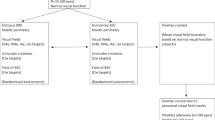Abstract
•Background: Comparing the results in a patient tested with two different automated perimeters can be difficult. The purpose of this study is to derive and test formulas for conversion between threshold values of every single test location and indices measured with Octopus and Humphrey perimeters. • Methods: We tested 50 eyes of 27 patients with program G1 of the Octopus perimeter and program 24-2 of the Humphrey Field Analyzer. All pairs of tests were performed on separate days but within 1 month of each other. Twelve eyes had normal visual fields, and 38 eyes had mild to moderate glaucomatous defects. Thirty-three eyes were chosen to determine empirically prediction equations for each test location and for each of the global indices, while the 17 remaining eyes were used to test the validity of the predictions. • Results: The mean absolute difference (i.e. the mean of the absolute values of the differences) between the predicted and the actual Octopus thresholds was 4.2±1.6 dB. The mean absolute difference between the predicted and the actual Humphrey thresholds was 5.7±1.6 dB. These differences were lower than the mean expected 5th to 95th percentile range of long-term fluctuation (10.3±2 dB for the Octopus fields and 9.2±2.2 dB for the Humphrey fields).• Conclusion: Conversion formulas between Octopus and Humphrey formats can be used, with a known error of the estimate, to compare the perimetric results of the patients tested with the two instruments.
Similar content being viewed by others
References
Anderson DR, Feuer WJ, Alward WL, Skuta GL (1989) Threshold equivalence between perimeters. Am J Ophthalmol 107:493–505
Boeglin RJ, Caprioli J, Zulauf M (1992) Long-term fluctuation of the visual field in glaucoma. Am J Ophthalmol 113:396–400
Flammer J, Jenni F, Bebie H, Keller B (1987) The Octopus glaucoma G1 program. Glaucoma 9:67–72
Heijl A, Lindgren A, Lindgren G (1989) Test-retest variability in glaucomatous visual fields. Am J Ophthalmol 108:130–135
Johnson CA, Keltner JL, Lewis RA (1987) JASW (joint automated weighting statistic). A method of converting results between automated perimeters. Doc Ophthalmol Proc Ser 49:563–568
Messmer C, Flammer J (1991) Octopus program GIX. Ophthalmologica 203:184–188
Vivell PM, Lachenmayer BJ, Schaumberger MM, Zimmermann P, Dietrich J, Bain C (1993) Conversion of normal visual field data between the Humphrey Field Analyzer 640, the Rodenstock Peristat 433, and the Octopus 1–2–3. In: Mills RP (ed) Perimetry update 1992/1993. Kugler, Amsterdam, pp 353–357
Author information
Authors and Affiliations
Rights and permissions
About this article
Cite this article
Zeyen, T., Roche, M., Brigatti, L. et al. Formulas for conversion between Octopus and Humphrey threshold values and indices. Graefe's Arch Clin Exp Ophthalmol 233, 627–634 (1995). https://doi.org/10.1007/BF00185283
Received:
Revised:
Accepted:
Issue Date:
DOI: https://doi.org/10.1007/BF00185283




